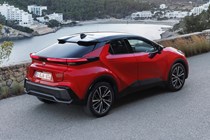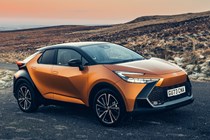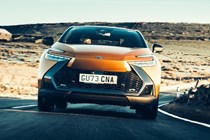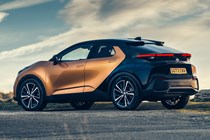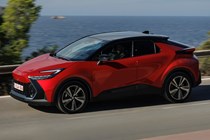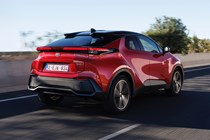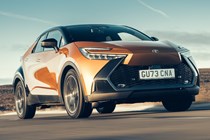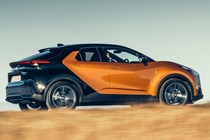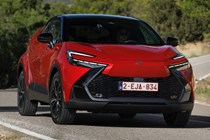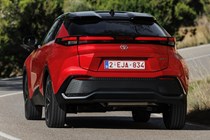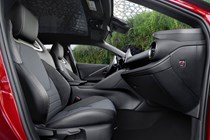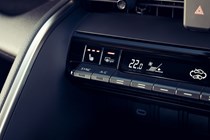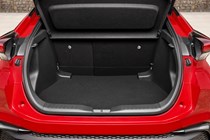
Toyota C-HR long-term test
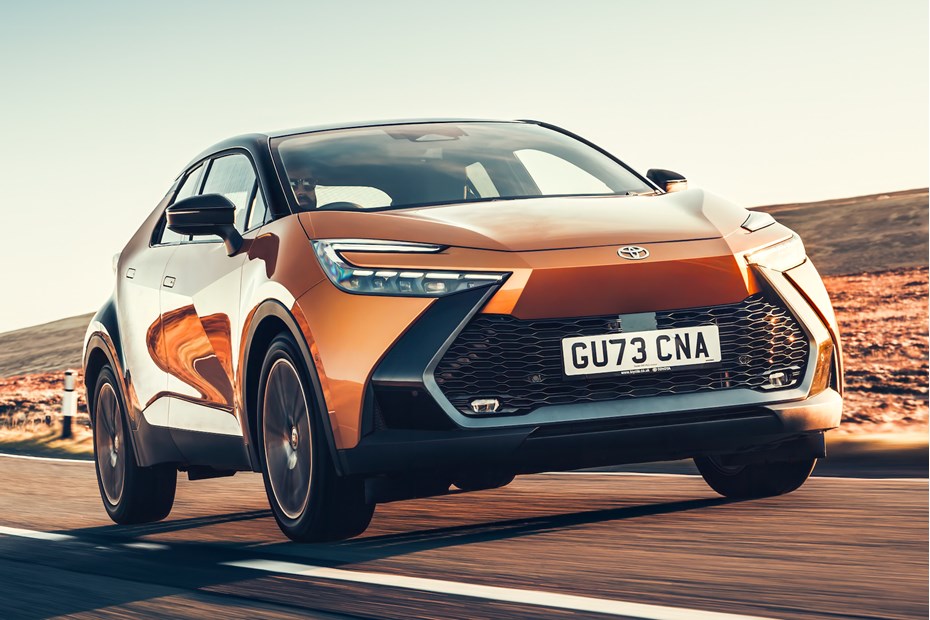
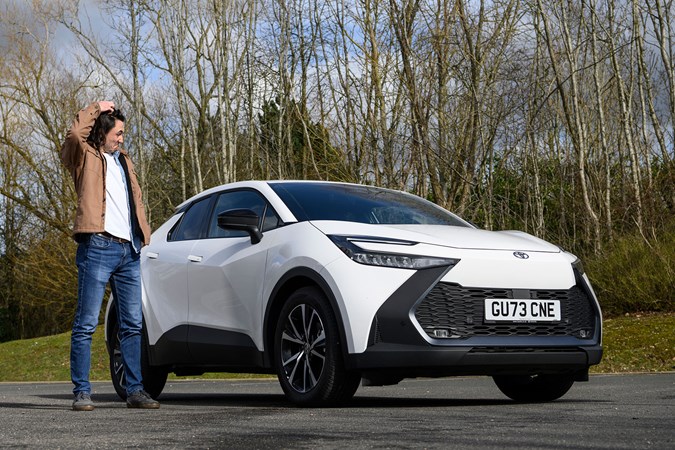
Our Deputy Editor, Luke Wilkinson, will be running a Toyota C-HR for the next six months. Its efficient hybrid powertrain might just suit his long-distance mileage demands, but does it offer anything else to capture his attention? Scroll down to find out.
Update 1: Welcome
As you can probably tell from my confused facial expression in the header image above, the Toyota C-HR isn’t really my sort of car.
Yes, I appreciate that’s a terrible way of opening a new long-term report but, before I decided to take that stance, I’d stared at a blank page for more than hour searching for a jumping-off point.
This isn’t the C-HR’s fault. I mean, I’m a keen driver and a staunch anti-SUV activist. Plus, I have an irrational fear of nearly all driver assistance technology and I’m still yet to find a CVT-equipped powertrain that hasn’t forced me into a spiralling state of depression.
So, because of my own shortcomings, the C-HR does little to excite me. However, I can understand how other drivers (with less exacting and prescriptive standards) could find it very attractive indeed.

It shares the Corolla’s unrelentingly indestructible running gear, it can achieve an easy 50mpg in the real world, it’s brimming with equipment and, if you service it at a main Toyota dealer, you can have it with an industry-leading 10-year warranty. With your sensible hat on, it makes an awful lot of sense.
Toyota’s customers seem to think so, too. The previous-generation version of the C-HR racked up more than 840,000 sales in Europe alone – and Toyota is hoping the cosmetic and technological improvements it’s made to this new model will be enough to drive those sky-high figures into the stratosphere.
But are the changes enough to win me over? For the next six months, I’ll be living with this C-HR, bringing you regular updates on everything that delights and frustrates me. And I promise I’ll leave my high horse in the stable for as long as I can.
Tell us more about your C-HR’s specs
The C-HR I’m running is trimmed in Toyota’s middling Design specification. If you can resist the urge to fiddle around with the car’s options list, it’ll cost you £34,695. I’ll admit, that sounds rather expensive when you compare it to a £20,000 Dacia Duster Extreme or a £30,000 Skoda Karoq SE L. Just remember that the Toyota comes with a hybrid powertrain as standard, which jacks up its price.
Even so, there’s no avoiding the fact that the C-HR’s rivals are better value. The Karoq SE L, for example, features all the interior technology you get on a C-HR Design, along with a heated steering wheel and plush microsuede upholstery for £4,000 less.
Toyota’s counter argument is that you’ll see back the extra money you spend on the C-HR in fuel savings. But I’ve done the maths and, even after 60,000 miles of driving, you’ll only spend an extra £1,750 on fuel for the Skoda. That isn’t enough to offset the C-HR’s higher purchase price.
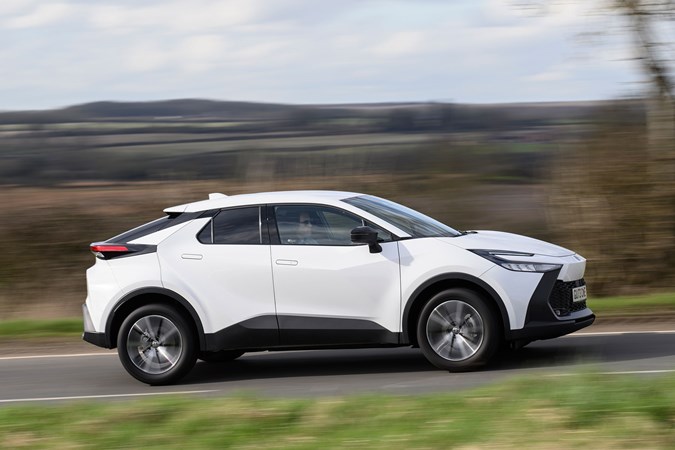
But I can feel myself getting dangerously close to saddling my horse, so I’ll focus on some of the things I like about the C-HR. Namely, its interior. I’m very fond of the way the dashboard wraps around the driver and I’m particularly grateful for the Design model’s larger 12.3-inch infotainment system and wireless Android Auto connectivity.
It works seamlessly, which is great if you’re like me and love using Waze for navigation. Once you’ve paired your phone to the car, the connection is automatic – and it’s proved very reliable thus far. I reckon it’s worth splashing the extra cash for this upgrade alone.
Design-spec cars also come with a wireless smartphone charger as standard. This is a great idea in principle, but I’ve found it to be a bit of a white elephant. It isn’t powerful enough to reliably shove electricity through my phone case and into my device. That means the charging is intermittent, which means my phone screen flashes like a rave torch as it constantly connects and disconnects from the charger.
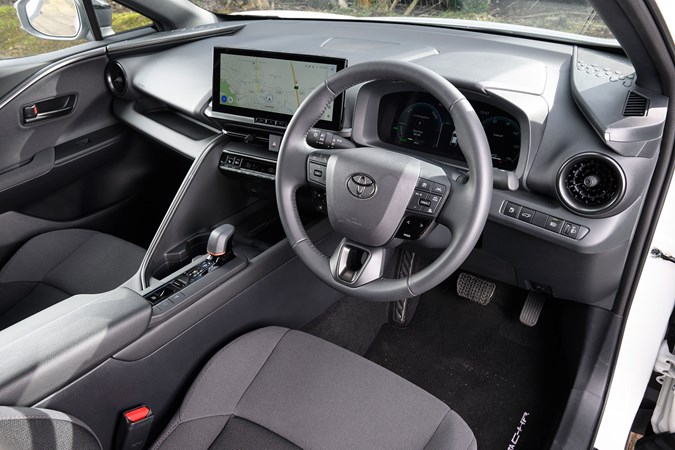
The ranch beckons once again, though, so I’ll move on to the C-HR’s engine. It’s a 1.8-litre self-charging hybrid powertrain with 140hp. Toyota says that’s enough for a 0–62mph time of 10.2 seconds. More importantly, however, the C-HR has an official WLTP fuel economy figure of between 57.6 and 60.1mpg – and I’ll be keeping a close eye on its performance over the coming months.
Before I launch into some initial driving impressions, I’d like to make one last observation about my C-HR’s spec – and I reckon it’ll be salient if you’re shopping for one. I really wish Toyota had painted it a better colour.
Take a look at the burnt orange car in our main Toyota C-HR review gallery and tell us that two tone paint finish doesn’t look a million times better than the drab shade of Hotpoint white my long-termer is finished in.
The C-HR is quite a funky shape, so I think it’s important that it’s finished in a colour that celebrates that. This single-tone finish completely masks the car’s exciting lines and, as I’ll now explain, the rest of the car isn’t interesting enough to make up the shortfall.
Okay. Can you elaborate on that?
In March 2024, I attended the European launch of the Toyota C-HR plug-in hybrid. While I was there, the company’s product team walked me through their intentions for the car.
They said their goals for the C-HR were to make it look good, to make it efficient and to make it good to drive – in that order. Toyota knew its target audience would be more concerned about styling, technology and efficiency than it would an engaging driving experience, so it built the car to suit.
Now, to be clear, I have absolutely nothing wrong with that. That approach makes great business sense. However, it also means the C-HR has very little character – and that means the entry-level models can feel a little boring, especially if you forgo the fancy tech and snazzy paint finish.
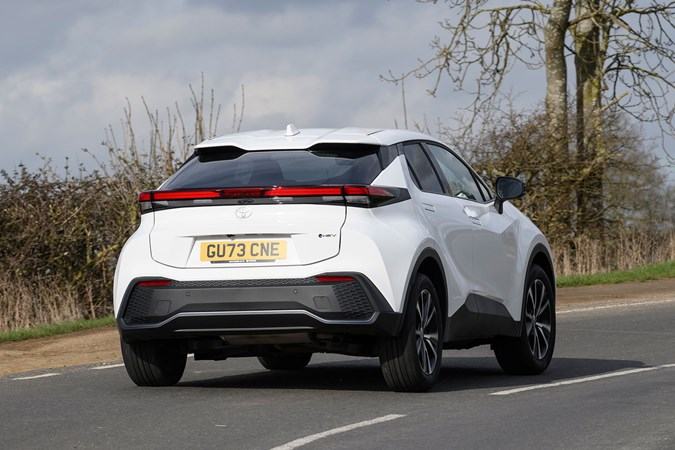
I’ve covered around 1,000 miles in the C-HR so far and, although they’ve all be very comfortable and efficient, they’ve also been rather forgettable. The two main emotions I’ve felt are disappointment from the car’s clinical steering system and frustration from the driver assistance tech that you can’t turn off unless the car is stationary.
For the time being, rivals such as the Ford Puma and Skoda Karoq seem far more appealing to me – but maybe that’ll change in the coming months. At least I haven’t spent a lot of money on fuel. Every cloud and all that.
| Current mileage | 2,452 |
| Real-world average fuel economy | 49.1mpg |
| Official combined fuel economy (WLTP figures) | 60.1mpg |
| Car joined Parkers fleet | April 2024 |
Update 2: Back in the C-H(H)R

My long-term Toyota C-HR and I have spent a couple of weeks apart, as I’ve been busying myself razzing an Alfa Romeo and a Lotus SUV around rural Britain. But now I’m back in its (rather sterile) embrace, I thought it would be a useful to talk about some of the things I’ve missed about it. And yes, that title is a half-hearted Beatles reference.
The C-HR and I have reunited after a brief spell apart. The separation wasn’t the car’s fault, either. It was mine. An Alfa Romeo Giulia Quadrofoglio appeared at the office – and that’s my favourite new car on sale. Hell, it might even be my all-time favourite car.
I’d have one over any Ferrari, any modern Maserati and, crucially, any of the usual German sports saloons. So, I dropped everything I was doing (my editor still hasn’t forgiven me), won the long and bloody brawl for the keys and promptly sodded off up the A1 to find out just how good it was on Cumbria’s twistiest fell roads.
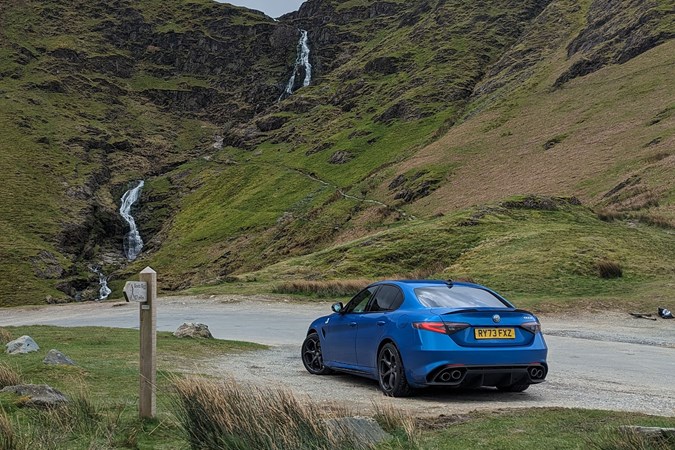
Now isn’t the time to wax lyrical about how good the Giulia QV was, but I’ll give you the abridged version. If you’re in the market for a sports saloon please, for the love of whatever religious or spiritual rulebook you subscribe to, buy one before Alfa pulls it from its showrooms. Fast saloons will never get any better than this – and anyone who disagrees with me can keep their opinions to themself. Because they’re wrong.
Luke. This is supposed to be a long-term report for the C-HR…
I know. I’m getting back on track. Bear with me for another paragraph. Once Alfa’s delivery driver prised the keys from my iron-clad palm, I spent a morning at the helm of the new (and entirely forgettable) Lotus Eletre R. Then, I jumped back into the Toyota C-HR – and I found a new respect for the car.
Toyota really designed the C-HR’s interior well. I was especially impressed with its infotainment screen after stepping out of the Lotus. It’s a symphony of user friendliness. I’m staggered that Lotus, which lives under the same technical umbrella as Volvo these days, can’t manage to give the £120,000 Eletre a straightforward menu system.
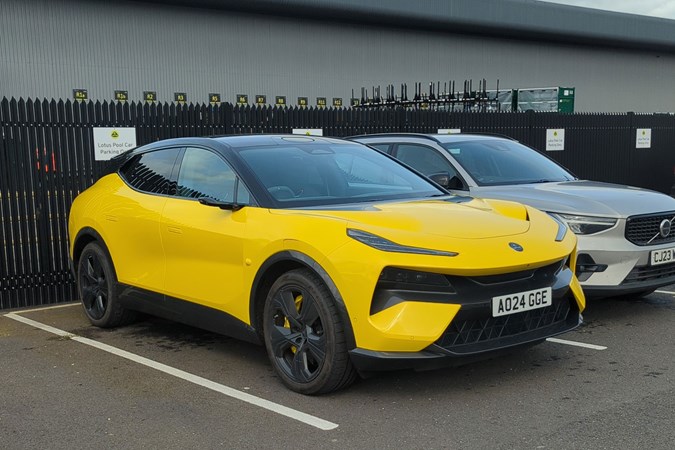
It’s a mess. The Android Auto layout is displayed in a window over Lotus’s native UX – and you can see the car’s built-in sat-nav scrolling past behind Waze. You also have a stupid display on the right-hand side of the screen that shows you the position of the car in your lane, which means you need to stretch halfway across the dashboard to operate everything you want to interact with.
The £30,000 C-HR does it way better. Its standard menu design is utterly logical and, when you use Android Auto, it occupies the entire screen. The C-HR’s screen is also a lot wider than the Eletre’s, so you can read you nav instructions with greater ease.
Anything else you’ve missed about the C-HR?
It’s easy to drive. I think my previous report was tainted by the fact I’d ploughed through a spate of soulless electric cars and dull family SUVs. But, having wrestled with more than 2,000hp for the past couple of weeks, it was kind of refreshing to be back behind the wheel of a car that could basically drive itself home.
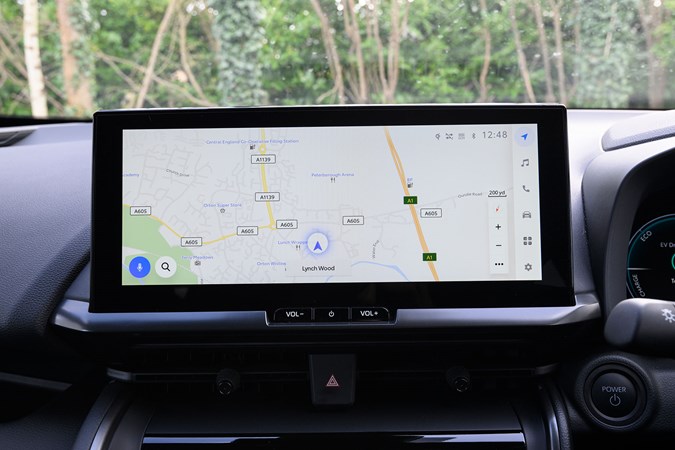
I guess that’s the appeal of the C-HR. It doesn’t add to the burden of a busy lifestyle by being difficult to operate. The infotainment system always pairs with my phone, I barely ever need to fill it up and I’ve never felt like I’m wrestling with the controls. It’s the same sort of thinking Apple deploys for its products, which is probably why Toyota sells so many.
Any issues to report?
One and, again, it wasn’t the Toyota’s fault. I was driving along the A1 when a massive Range Rover screamed past and kicked a stone up at the windscreen. I now have a chip just off to the right of my line of sight – and I’m hoping it doesn’t turn into a crack.
I have informed Toyota about it, but the glass company it uses must be snowed under with work because I’m yet to have it repaired. I’ll keep you updated on the process.
| Current mileage | 3,217 |
| Real-world average fuel economy | 48.7mpg |
| Official combined fuel economy (WLTP figures) | 60.1mpg |
| Car joined Parkers fleet | April 2024 |
Update 3: That sinking feeling
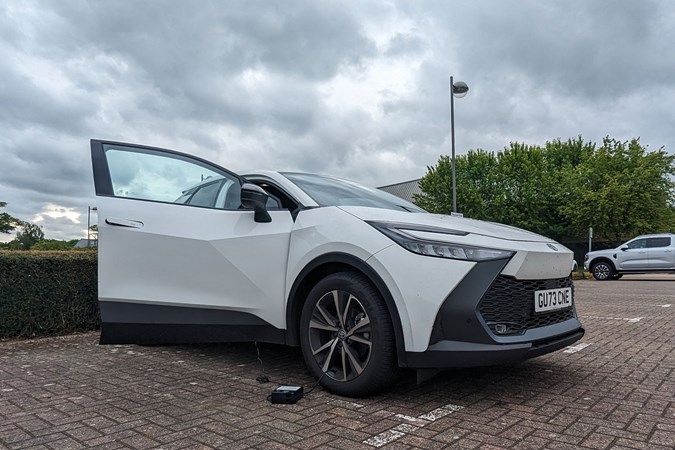
I’ve covered another couple of thousand miles in the Toyota C-HR – and it seems my unrelenting schedule is starting to take its toll. The front driver’s tyre now has a slow puncture, which has made living with the car rather inconvenient. And because I’m always on the road, I struggled to get it mended as quickly as I would have liked.
Punctures are perilously close to the top of my list of least favourite things, sitting somewhere between cucumbers and disobedient technology. Why? Well, it irritates me that such a simple component can turn a £30,000 vehicle into an elaborate piece of law art. What frustrates me even more is that manufacturers have made it much harder to manage punctures with their remorseless quest to trim their CO2 emissions.
In the old days, if you got a puncture, you simply replaced your damaged wheel with the full-size spare in your car’s boot. But you’ll struggle to find a new car with even a space saver now. Spare wheels add weight and weight increases pollution so, to keep in the EU’s good books, car makers have binned them off. Instead, almost every new car I’ve driven this year has a tin of tyre weld and a 12-volt compressor in its boot.
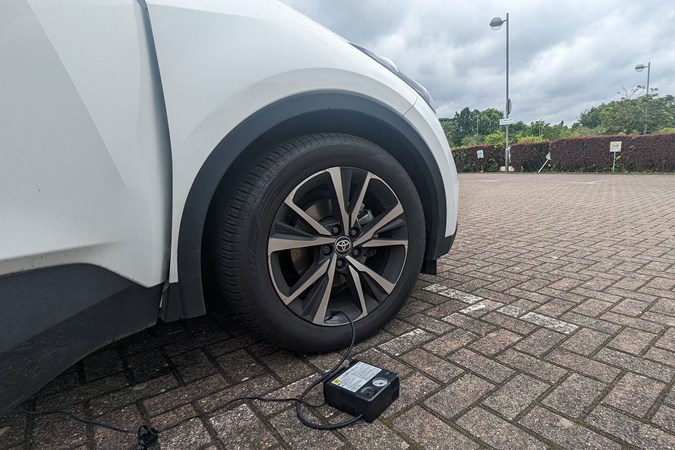
I’ve been trying to manage the C-HR’s puncture for a few weeks now, simply because I haven’t been able to carve enough time out of my diary to get it repaired. I didn’t want to resort to using tyre sealant, either. Every tyre fitter I’ve ever spoke to hates the stuff with a passion as it has the consistency of warm treacle which makes it damn-near impossible to remove from the inside of an alloy.
My decision to live with the C-HR’s puncture was made more difficult by Toyota’s weedy factory-delivered air compressor. It barely has enough waft to overcome the seal on the Schrader valve – and that meant it was taking me a good five minutes to inflate the tyre enough to make it safe to drive on.
Standing around for that length of time in the torrential rain on the side of the A66 is more than enough to soak you through to your organs and ruin the rest of a 200-odd mile drive back to Lincolnshire. Ask me how I know.
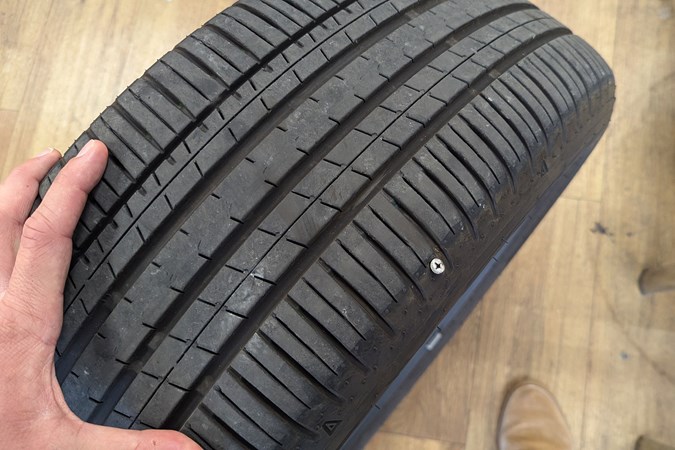
Mercifully, my good mate Ryan Gilmore (who just so happens to be Parkers’ Deputy Commercial Content Editor), took pity of my plight and gifted me a shiny new Ring RAC830 12-volt compressor. It’s currently the top product in our list of the best tyre inflators – and for good reason.
It packs a real punch, reinflating my stricken C-HR’s tyre in less than a minute. I’ve used slower shop compressors – and Ryan’s generosity was especially appreciated as I was having to stop at least once every two days to refill the C-HR’s tyre. If you’re in the market for an air compressor, I strongly suggest you buy one immediately.
Getting my act together
After three weeks of bumbling around on a tyre that sealed about as well as a TEMU pressure cooker, I finally booked the C-HR in for a repair. I took it to a branch of Kwik Fit in Peterborough for what I hoped was going to be an easy patch job on a dinky pin hole.
I couldn’t have been more wrong. After the technician had whipped off the Toyota’s wheel, he rolled it into the waiting room and pointed to a massive screw sticking out of it. To add insult to injury, the offending hardware was rammed into the inside edge of the tyre, right next to the sidewall (as illustrated by the image above) – and that meant it couldn’t be repaired.
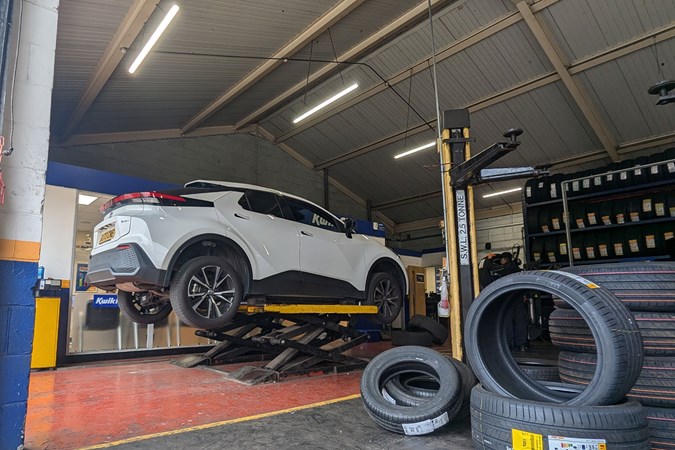
So, Kwik Fit relieved me of £165 and wrapped the C-HR’s front driver’s wheel in a new, low-rolling resistance Bridgestone tyre. However, that could throw up a new set of problems because the rest of the C-HR’s tyres are Falkens.
Normally, I’d never put two different brands of tyre on the same axle, as that can negatively affect a car’s handling. Sadly, the branch of Kwik Fit I visited didn’t have any Falkens in stock, so I had no choice but to settle for the Bridgestone. I’ll monitor the car’s handling over the coming weeks and update you if it’s changed for the worse.
| Current mileage | 6,105 |
| Real-world average fuel economy | 48.9mpg |
| Official combined fuel economy (WLTP figures) | 60.1mpg |
| Car joined Parkers fleet | April 2024 |



